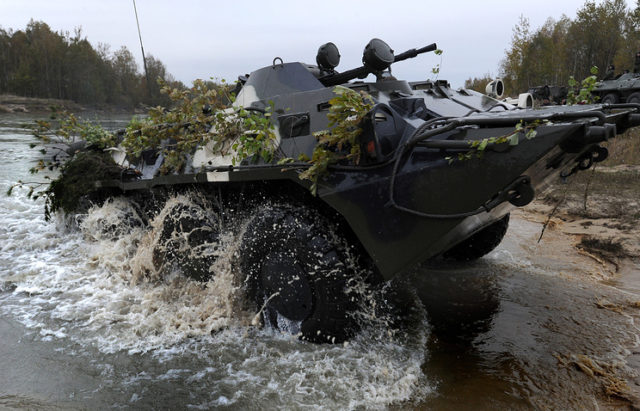
Having Lost ‘Soft’ Power in Post-Soviet Space, Moscow Increasingly Using ‘Hard’
Publication: Eurasia Daily Monitor Volume: 14 Issue: 78
By:

The aggressiveness Moscow has shown in its relations with countries in the former Soviet space reflects Russia’s loss of influence via “soft” power channels. At the same time, the Kremlin’s demonstrated bellicosity simply exacerbates that loss. Consequently, if President Vladimir Putin is going to rebuild Russia’s sway over the region, as he hopes, he will increasingly have to rely on “hard” power, including military and economic pressure. That—more than any of his personal preferences—explains Putin’s actions up to now, and it sets the stage for the further decomposition of the former Soviet space and for more violence as this process continues. And this trend will necessarily involve outside powers, ranging from China to the Middle Eastern states to the West.
Since the collapse of the Soviet Union, Moscow has been losing what it expected to be its primary means of holding onto the extended geographic space previously under its control: the number of ethnic Russians in neighboring post-Soviet countries has declined sharply, as has the number of Russian speakers. Moreover, ever more former Eastern Bloc or post-Soviet countries have or are reorienting themselves away from Moscow by seeking membership in the North Atlantic Treaty Organization (NATO) or the European Union; many are even dispensing with the Cyrillic alphabet, which Moscow earlier imposed, or are at least talking openly about doing so (Dsnews.ua, June 10; see EDM, April 25). Meanwhile, Russian aggression—first in the so-called “frozen conflicts” like Transnistria, then in Georgia and now in Ukraine—has backfired, alienating ever more non-Russian countries from Russia and helping to solidify their independent existence. And although the economy of Russia is still better off than some in the region, as the massive influx of guest workers from Central Asia and the Caucasus shows (see EDM, February 18, 2014; September 15, 2015; May 22, 2017), it is much weaker than it was over a decade ago and cannot compete with the economies of China or Western countries.
Moscow might have compensated for this weakening regional posture by developing contacts with the rising generations of leaders in these neighboring post-Soviet countries. For instance, it could have done more to encourage them to study in Russia, or by other means. But it has failed to do that. And now, a quarter of a century after the Soviet Union fell apart, Moscow has lost the ability to affect outcomes in most if not all of the post-Soviet states, according to Russian analyst Vladislav Inozemtsev. Instead, he writes, the Russian government has to use force or the threat of force to get its way. That may work in the short term but is counterproductive over the long haul (Gazeta.ru, June 6).
In short, Moscow has lost two of the three elements in the trinity of resources that define a hegemonic power: It no longer provides an attractive model for others to emulate, and it does not have the economic strength to leave them with no choice but to become part of its orbit. What it retains, at least for now, is the third element of that triad: disproportionate military strength. And consequently, it is not surprising that across the former Soviet space, Moscow is building up its military presence in the hopes of resisting the impact of the centrifugal forces its lack of other resources have unleashed.
Over the last six months, Moscow has beefed up its bases in Armenia, Kyrgyzstan and Tajikistan, giving it the kind of military muscle that the governments of those three countries cannot ignore (Centrasia.ru, June 9). It has staged military exercises near the borders of other countries, from the Baltic States to Kazakhstan. And it has even organized exercises in countries of the Moscow-dominated Collective Security Treaty Organization (CSTO).
But perhaps most indicative of Moscow’s growing reliance on force as its only remaining tool of influence has been its actions in Belarus. Russia has long pressed Alyaksandr Lukashenka’s government for the rights to set up a base there, but the Belarusian leader has resisted. Lukashenka recognizes that the creation of such a base would severely limit his ability to navigate between Moscow and the West, something he is now compelled to do because Moscow no longer has the ability to provide the economic assistance his country requires. Moreover, Belarusians are increasingly viewing themselves as separate and apart from Russians, all of Moscow’s propaganda notwithstanding (RT, June 4; see EDM, June 8).
Many analysts in Moscow, Minsk and the West have been focusing on the possibility that Russia may use the Zapad 2017 military exercise in Belarus to force Lukashenka to change course or even to depose him and seek the incorporation of Belarus into the Russian Federation, much as Moscow did with its annexation of Crimea. The more hyperbolic predictions are almost certainly wrong (see EDM, March 8), but there is no question that Russia will seek to use its massive military presence during and perhaps after the exercise to put new pressure on Lukashenka and his regime (see EDM, January 20).
That conclusion is suggested by another military exercise now taking place in Belarus that may be a bellwether of what will happen this summer. Specifically, the “Slavic Brotherhood” counter-terrorism operation includes soldiers and—what is especially important—political figures from Russia, Serbia and Belarus. Notably, it appears designed to coerce Minsk more than to test anti-terrorism cooperation (Camarade.biz, June 5; Rossiyskaya Gazeta, June 9; Newsland.com, U-f.ru, June 8; Naviny.by, June 6).
All too often, analysts in the West have focused on each specific Russian action in isolation or seen them as manifestations of some Putinist grand design. But the collapse of Russian “soft” power provides an explanation for all such activities as well as for Putin’s neo-imperialism: Russia simply does not have any other way to try to hold this region. And consequently, it can be expected to use force more, not less often in the future.



